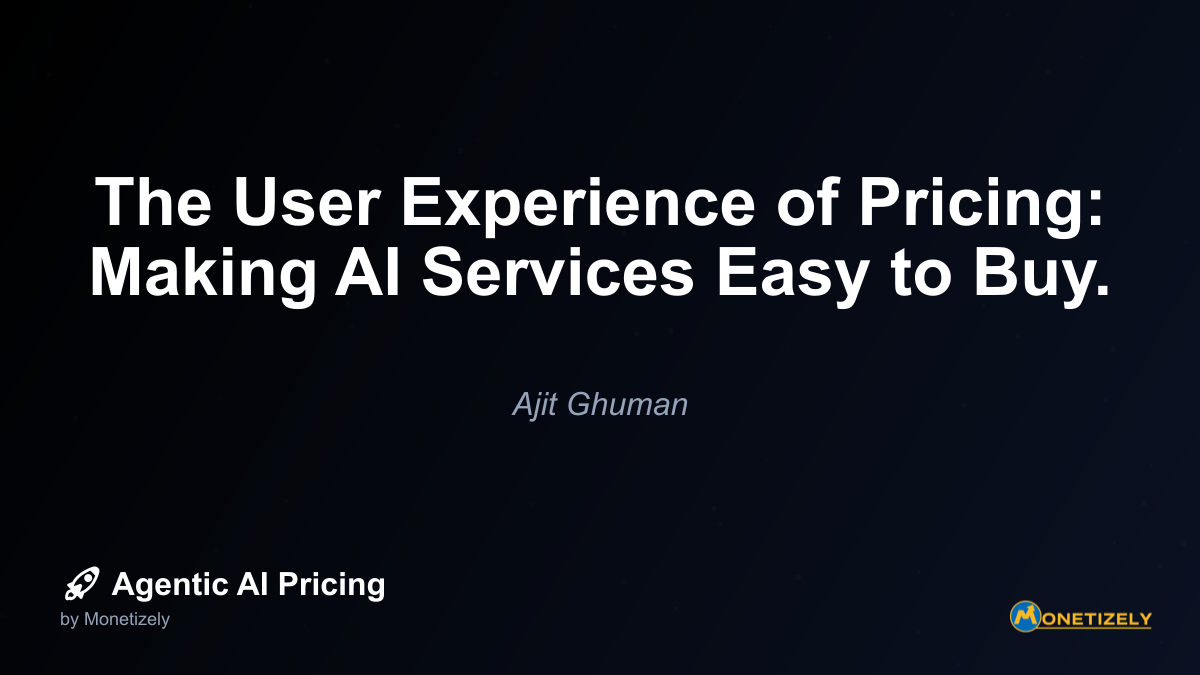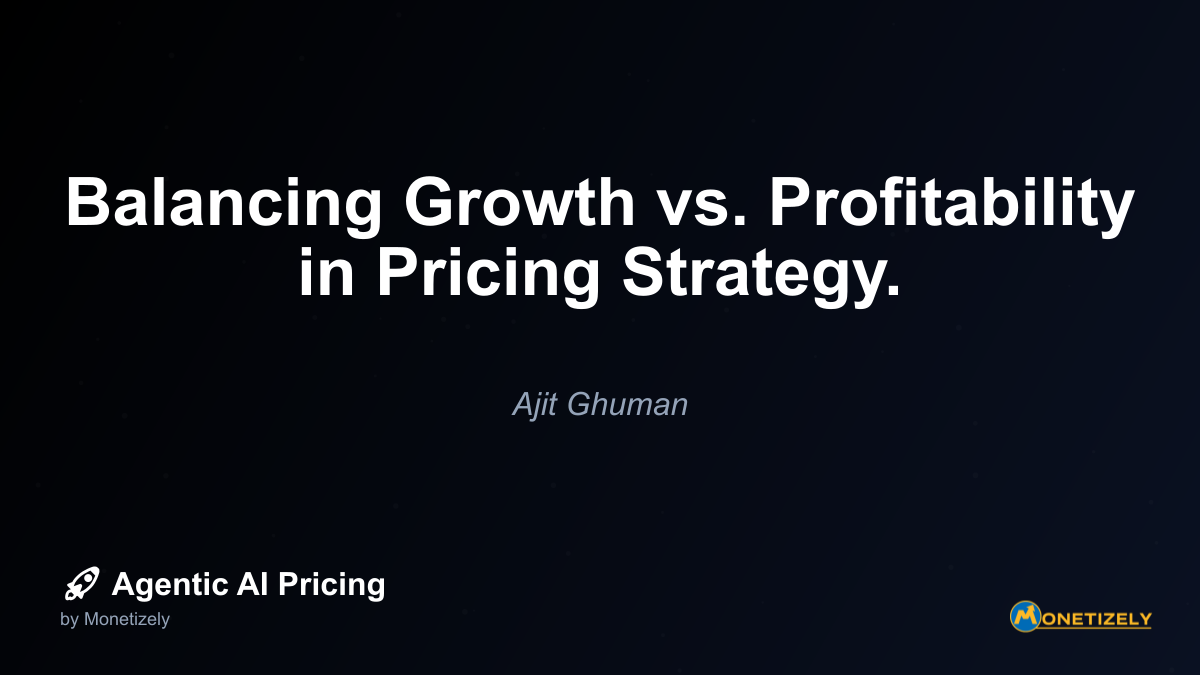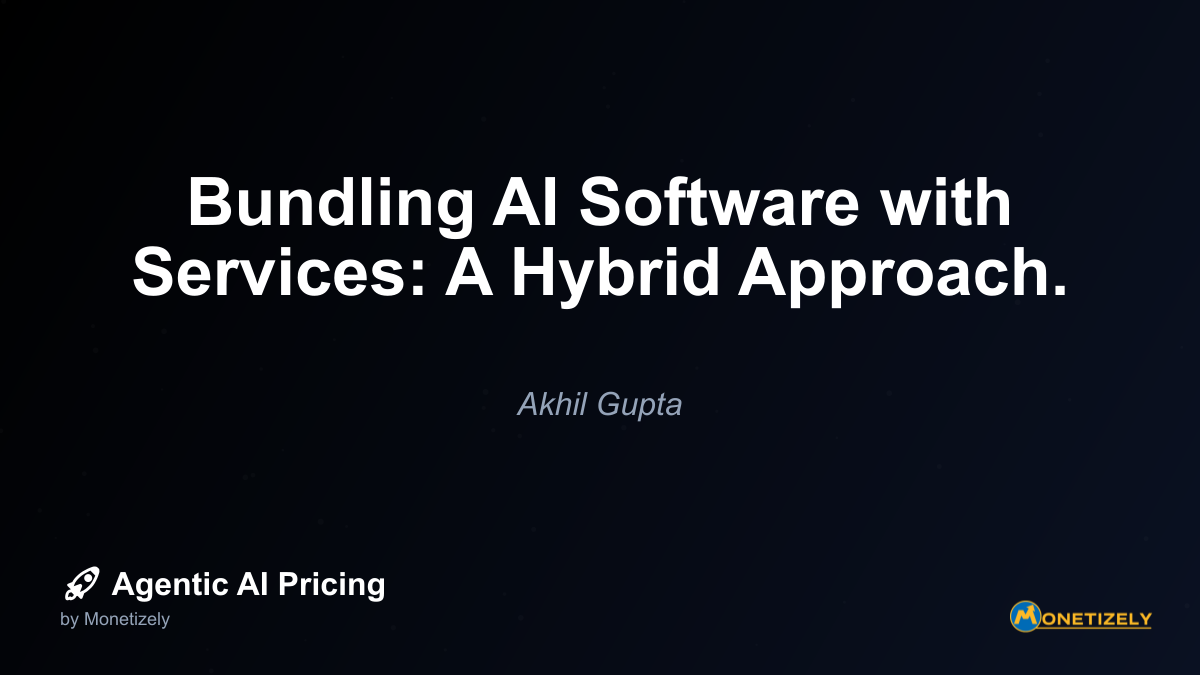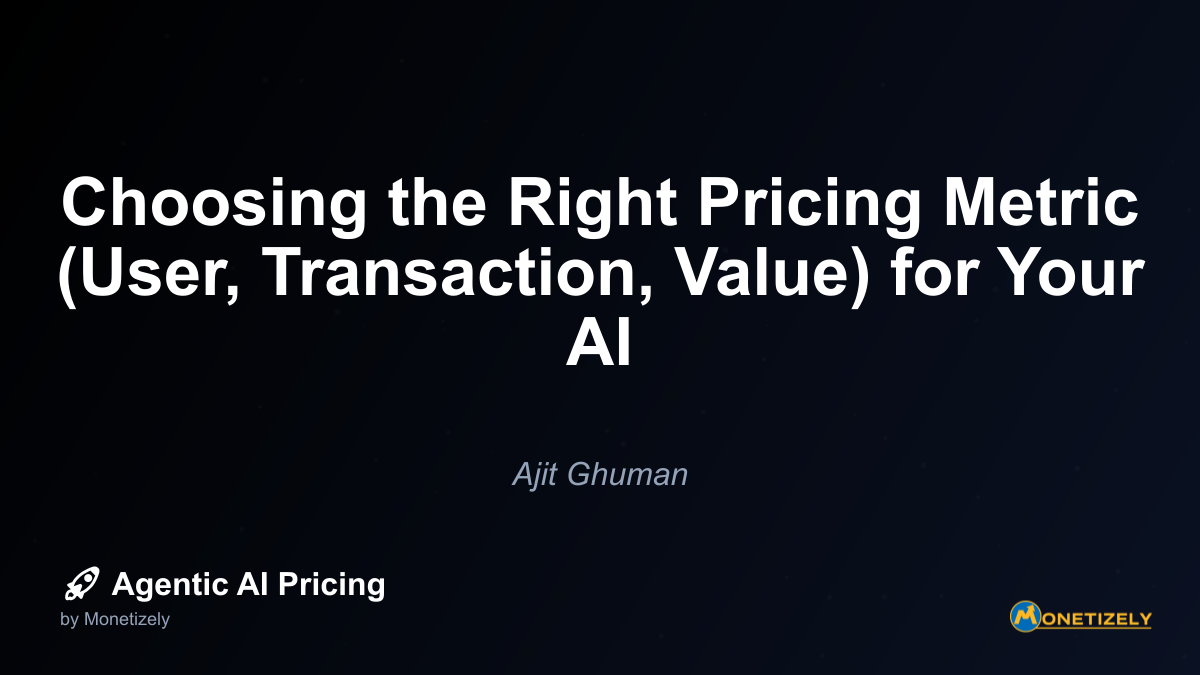· Ajit Ghuman · Strategy & Planning · 9 min read
The User Experience of Pricing: Making AI Services Easy to Buy.
AI and SaaS Pricing Masterclass
Learn the art of strategic pricing directly from industry experts. Our comprehensive course provides frameworks and methodologies for optimizing your pricing strategy in the evolving AI landscape. Earn a professional certification that can be imported directly to your LinkedIn profile.

Elements of Effective Pricing UX for AI Services
Creating a frictionless pricing experience requires attention to several key elements that collectively shape how customers perceive, understand, and interact with your pricing model.
1. Transparent Pricing Structure
Transparency builds trust, especially critical for AI services where customers may already harbor concerns about data usage or algorithmic decisions. Effective transparency includes:
- Clear unit economics: Explicitly define what constitutes a “unit” (API call, token, minute of compute time)
- Visible scaling factors: Show how costs change as usage increases
- Upfront disclosure of all fees: No hidden costs or surprise charges
- Plain language explanations: Avoid technical jargon when explaining pricing components
According to a recent study on how VCs evaluate AI pricing pages, investors increasingly view pricing transparency as a competitive advantage rather than a vulnerability, with transparent companies securing funding at higher rates than those with opaque models.
2. Interactive Cost Calculators
Cost predictability ranks among the top concerns for enterprise AI adoption. Interactive calculators address this by allowing customers to:
- Input expected usage patterns
- See projected costs under different scenarios
- Compare pricing tiers based on their specific needs
- Receive recommendations for optimal configurations
The most effective calculators follow these design principles:
- Progressive disclosure: Start simple, revealing complexity only as needed
- Visual feedback: Use charts and graphs to illustrate cost changes
- Scenario comparison: Allow side-by-side evaluation of different options
- Default settings: Pre-populate with typical usage patterns for your customer segments
For example, OpenAI’s pricing calculator allows users to estimate costs based on input/output tokens, making the otherwise abstract concept of token-based pricing more concrete and predictable.
3. Value-Oriented Presentation
Rather than focusing solely on technical specifications or raw costs, effective pricing UX frames expenses in terms of value delivered:
- Outcome-based language: “Analyze 1,000 customer support tickets” rather than “Process 100MB of text”
- ROI calculators: Show projected returns alongside costs
- Value benchmarks: Compare your solution’s cost to alternatives or manual processes
- Customer success stories: Integrate testimonials highlighting value realization
This approach shifts customer thinking from “How much does this cost?” to “What return will I get on this investment?“
4. Simplified Tier Navigation
When offering multiple service tiers, the presentation and navigation between options significantly impacts decision-making:
- Limited options: Present 3-4 tiers maximum to avoid choice paralysis
- Clear differentiation: Highlight the key differences between tiers
- Recommended options: Designate a “most popular” or “best value” tier
- Feature comparison: Use visual cues (checkmarks, highlighting) for quick scanning
The goal is to help customers quickly identify which tier best matches their needs without extensive analysis.
5. Flexible Billing Options
Billing flexibility reduces friction in the purchasing process:
- Multiple payment methods: Support credit cards, ACH, wire transfers, and emerging payment options
- Adjustable billing cycles: Offer monthly, quarterly, and annual options with appropriate incentives
- Currency options: Support major currencies for international customers
- Consolidated billing: Provide unified invoices for organizations using multiple services
Enterprise customers particularly value billing flexibility that aligns with their procurement processes and budget cycles.
Common Pricing UX Pitfalls in AI Services
Even well-intentioned pricing strategies can create frustrating user experiences. Here are the most common pitfalls to avoid:
Overwhelming Technical Complexity
Many AI services present pricing in highly technical terms that make sense to engineers but bewilder business users. For example, describing costs in terms of “inference compute units” or “embedding dimensions” without clear explanations creates unnecessary friction.
Solution: Provide both technical and business-friendly descriptions of pricing units, with the latter prominently displayed.
Unpredictable Usage-Based Costs
Pure consumption-based pricing creates anxiety about runaway costs, especially for AI services where usage can spike unexpectedly.
Solution: Implement usage caps, alerts, and hybrid models that combine predictable base fees with variable components.
Hidden Thresholds and Breakpoints
Some pricing models contain sudden cost increases at certain thresholds that catch customers by surprise.
Solution: Clearly visualize cost curves, highlighting where significant changes occur, and provide advance notifications when customers approach these thresholds.
Disconnected Value and Price
When pricing units don’t align with customer-perceived value, the disconnect creates friction. For instance, charging based on processing time when customers care about document throughput.
Solution: Align pricing metrics with customer value metrics, even if this requires internal translation between technical resource usage and customer-facing units.
Excessive Customization Requirements
When every customer needs a custom quote, the sales process becomes a bottleneck and transparency suffers.
Solution: Standardize pricing for common use cases while reserving custom quotes for truly unique situations.
Implementing Better Pricing UX: A Practical Framework
Improving the user experience of your AI service pricing isn’t just about aesthetics—it requires a systematic approach that spans design, communication, and ongoing optimization.
Step 1: Map the Customer Journey
Before redesigning your pricing experience, map the complete customer journey from initial pricing research to ongoing billing interactions:
- Discovery phase: How do customers first encounter your pricing?
- Evaluation phase: What information do they need to assess fit?
- Decision phase: What pushes them toward commitment?
- Onboarding phase: How do they configure their initial setup?
- Usage phase: How do they monitor and manage costs?
- Renewal phase: What information influences continuation?
Identifying friction points across this journey provides the foundation for targeted improvements.
Step 2: Simplify Without Sacrificing Accuracy
Simplification doesn’t mean oversimplification. The goal is to make pricing mentally manageable while maintaining accuracy:
- Bundle related components: Group similar features or resources
- Standardize units: Use consistent measurements throughout
- Create logical hierarchies: Organize information from general to specific
- Progressive disclosure: Reveal details only when relevant
For example, rather than listing separate prices for different API endpoints, bundle them into functional categories with unified pricing.
Step 3: Design for Different User Types
Different stakeholders have different pricing information needs:
- Business decision-makers: Focus on ROI, total cost, and value alignment
- Technical implementers: Provide detailed specifications and resource requirements
- Finance/procurement: Supply billing details, contract terms, and compliance information
Create tailored views or resources for each audience while maintaining consistency in the underlying pricing model.
Step 4: Test with Real Users
Validate your pricing UX with actual customers through:
- Usability testing: Observe how users interact with pricing information
- Comprehension testing: Verify that users accurately understand costs
- A/B testing: Compare different presentations to identify optimal approaches
- Feedback collection: Gather direct input on pain points and improvements
These insights often reveal unexpected friction points that weren’t apparent to internal teams.
Step 5: Continuously Optimize
Pricing UX isn’t a “set and forget” element. Establish a process for ongoing improvement:
- Monitor key metrics: Track pricing page abandonment, support tickets related to pricing, time spent on pricing pages
- Collect ongoing feedback: Use surveys and interviews to assess satisfaction
- Benchmark against competitors: Regularly review competitor pricing experiences
- Update with new capabilities: Revise as your service evolves
Companies that treat pricing UX as a continuous improvement area typically see higher conversion rates and customer satisfaction.
Case Studies: Pricing UX Excellence in AI Services
Looking at real-world examples provides valuable insights into effective pricing UX implementation.
Case Study 1: Anthropic’s Claude API
Anthropic’s approach to pricing their Claude AI assistant API demonstrates several best practices:
What They Do Well:
- Clear per-token pricing with straightforward input/output rates
- Interactive cost calculator showing real-time estimates
- Context window visualization to help users understand token consumption
- Transparent comparison with competing models
Impact: Anthropic has seen faster enterprise adoption compared to similar services, with customers citing pricing clarity as a key decision factor.
Case Study 2: Zapier AI Actions
Zapier’s pricing for their AI automation capabilities showcases value-oriented presentation:
What They Do Well:
- Task-based pricing rather than technical metrics
- Tiered usage with soft caps rather than hard cutoffs
- Visual examples of what constitutes an “AI action”
- Integration of pricing into the workflow creation process
Impact: Zapier reports 32% higher conversion rates and 18% fewer pricing-related support tickets after implementing this approach.
Case Study 3: Jasper AI
Jasper’s approach to AI content generation pricing demonstrates effective tier navigation:
What They Do Well:
- Clear use-case based tier differentiation
- Interactive feature comparison table with category grouping
- Prominent display of word count allocations
- Seamless trial-to-paid transition with usage tracking
Impact: Jasper achieved a 27% increase in average contract value while reducing their sales cycle by 40% through pricing clarity.
Best Practices for Billing and Payment Processes
The billing experience forms the final—and often overlooked—component of pricing UX. Even the most transparent pricing model can be undermined by a cumbersome billing process.
1. Proactive Usage Notifications
Implement a system of proactive notifications to prevent bill shock:
- Usage threshold alerts (50%, 75%, 90% of limits)
- Unusual activity warnings
- Projected billing estimates
- Pre-renewal notices
These notifications help customers maintain control and avoid unexpected charges.
2. Self-Service Management Tools
Empower customers to manage their own usage and billing:
- Usage dashboards with historical trends
- Plan switching capabilities
- Add-on purchasing options
- Payment method management
- Invoice access and history
Self-service tools reduce support burden while increasing customer satisfaction.
3. Flexible Payment Options
Accommodate diverse customer preferences and requirements:
- Multiple payment methods
- Various billing cycles
- Enterprise billing integrations (PO systems)
- Tax documentation
- Multi-entity billing for large organizations
Flexibility removes payment friction that might otherwise delay adoption.
4. Clear, Detailed Invoices
Design invoices that reinforce value and provide necessary detail:
- Itemized usage breakdowns
- Period-over-period comparisons
- Resource utilization summaries
- Applicable discounts and promotions
- Contact information for billing questions
Transparent invoices reduce confusion and support inquiries.
The Future of Pricing UX for AI Services
As AI services continue to evolve, several emerging trends will shape pricing UX:
1. Dynamic Visualization
Advanced interactive tools will help customers visualize complex pricing scenarios, showing not just costs but value realization across different usage patterns and configurations.
2. Personalized Pricing Experiences
AI-powered recommendation engines will deliver personalized pricing experiences, highlighting the most relevant options based on a customer’s industry, size, and specific use cases.
3. Outcome-Based Pricing Models
More services will shift toward outcome-based pricing, where costs align directly with business results rather than technical resources, requiring new UX approaches to communicate value.
4. Integrated ROI Measurement
Pricing interfaces will increasingly incorporate actual ROI measurement, showing customers the ongoing value they’re receiving relative to their spending.
5. Collaborative Buying Experiences
As AI purchasing decisions become more collaborative, pricing UX will evolve to support multiple stakeholders with different information needs and approval workflows.
Conclusion: Making Pricing a Competitive Advantage
The user experience of pricing represents an underutilized competitive advantage in the AI services market. While competitors focus primarily on technical capabilities and raw price points, companies that create frictionless, transparent pricing experiences gain several strategic benefits:
- Shorter sales cycles with less negotiation
- Higher conversion rates from trial to paid
- Increased customer trust and loyalty
- Reduced support burden for pricing questions
- More predictable revenue forecasting
By applying the principles and practices outlined in this article, AI service providers can transform pricing from a necessary evil into a powerful differentiator that accelerates adoption and builds stronger customer relationships.
Remember that pricing UX isn’t just about making information accessible—it’s about making value obvious. When customers can easily understand what they’re paying for and why it’s worth it, the path to purchase becomes dramatically smoother.
For AI services specifically, where technology complexity often creates natural barriers to adoption, an exceptional pricing experience can be the difference between a customer who converts and one who continues searching for alternatives.
Co-Founder & CEO
Ajit is the author of Price To Scale, a top book on SaaS Pricing and is the Founder of Monetizely. Ajit has led and worked in pricing and product marketing at firms like Twilio, Narvar and Medallia. His work has been featured in Forbes and VentureBeat. Ajit regularly consults with software companies from Seed stage to post-IPO on pricing strategy. Ajit is also a highly-rated co-instructor for 'The Art of SaaS Pricing and Monetization' on Maven.
Pricing Strategy Audit
Let our experts analyze your current pricing strategy and identify opportunities for improvement. Our data-driven assessment will help you unlock untapped revenue potential and optimize your AI pricing approach.




